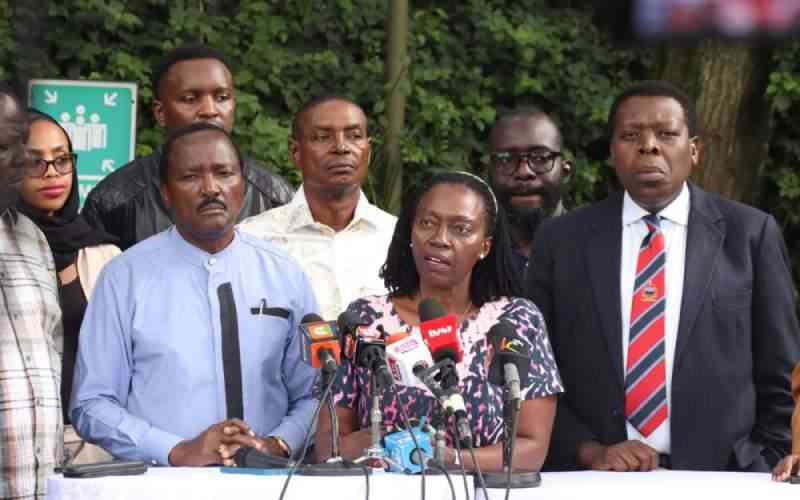 |
|
Wabera Daudi Dabaso and Family |
The mood in the country was euphoric. Finally after 70 years of colonial domination, the yokes of oppression had finally been shattered and a new crop of African leaders was steering Kenya into the community of nations as the newest independent state.
As most parts of the country eagerly waited for the all-important moment when the colonial flag would be lowered, residents of Northern Frontier district were jittery, unsure of what the new state would have for them.
A few months earlier, in 1962, residents in Northern Kenya had tried to break away from Kenya; convinced that they would be better off if their region was merged with the State of Somali.
Kenya’s political leadership would hear none of that and were determined not to yield even an inch of Kenyan soil to their more aggressive neighbours, Somalia.
The Government had just won the referendum called to determine whether the region was to remain in Kenya or be allied to Mogadishu but as fate had it, the Government won.
The Kenyatta regime had won the game of numbers but was yet to conquer the minds of the residents who felt they would be better off if they were administered from Mogadishu.
It is against this background that Jomo Kenyatta, then the designated Prime Minister, on January 15, 1963 authorised the posting of Daudi Dabasso Wabera as the district commissioner of Isiolo to try and win the hearts of the skeptics.
His brief was to hold a series of meetings and convince as many Kenyan Somalis as possible that all would be well under the new regime. He was to assure them that they would remain unmolested in Kenya.
As the date of Kenya’s independence drew nearer, some colonial administrators were uncomfortable with and were secretly fomenting rebellion among the residents of Isiolo, Wajir, Wajir, Mandera and Moyale.
“My dad had been posted there (Isiolo) to ensure there was peace and harmony but some British officers were unhappy. They hatched a plan to teach him a lesson and plunge the region in turmoil and make it ungovernable,” Said Wabera, Mr Wabera’s son, recalls.
The plans came to fruition a few weeks after Kenya got independence in June 1963. The schemers chose Sericho, a far-flung outpost, which was almost a day’s drive from Isiolo.
security meeting
It was chosen because of its proximity to the vast unmanned Kenya-Somalia border.
A few days after Kenya marked its first Madaraka Day, Wabera visited the area for a meeting with the local residents accompanied by an area chief, Galma Dido. And as the Government agents wound up their speeches, three assassins lay in wait in a thicket.
As the entourage left Sericho, the three gun men believed to have been on the orders of the then Somali Prime Minister Abdirahid Ali Sharmarke singled out the two administrators and killed them.
Stay informed. Subscribe to our newsletter
The officers attached to the district commissioner were unhurt. The assassins then left and drove towards the Kenya-Somalia border.
The news of Wabera and Dido’s killing reached Isiolo the following day, causing panic and a chain of reaction whose ripples continue to be felt to date.
In the meantime, although the death of the two Government officers was public knowledge, there appeared to be attempts to apprehend the men who had shed their blood.
When President Kenyatta learnt of the development, he was livid with anger against one Mr Pridgeon, the assistant commissioner of police who was in charge of the Northern Frontier region.
In the meantime, the situation in the region became fluid as the rebellion, which had been secretly boiling exploded into a wave of attacks.
The Peace Bulletin edition of April 2005, summarized the tragic turn of events as: “Six months to independence, a bullet that triggered a series of Kenya’s political assassinations was fired from a Patchett sub-machine gun along the Isiolo-Wajir border on June 28, 1963. A senior civil servant and a chief, while on their way back from Government duty in Sericho, Isiolo District, were brought down by a hail of bullets fired by secessionists who later fled to Somalia in a Landrover.”
wagalla massacre
According to the report, a week earlier, Kenyatta, had claimed there were plans to assassinate senior Government officials in a move calculated to cause discontent and division in Northern Kenya.
After the killing, Northern Frontier has never been the same again for the Government classified it as a closed district where anybody moving in or out of the area had to be cleared by the security agents.
A wave of insurrection swept across the region, climaxing into what came to be known as the Shifta war and the Wagalla massacre.
To many Kenyans, Wabera is just the name of street in the heart of Nairobi, which stretches from City Hall Way and connects with Kenyatta Avenue.
To the residents of Northern Kenya, the name evokes triggers memories of historical injustices visited on innocent people for over 51 years.
 The Standard Group Plc is a
multi-media organization with investments in media platforms spanning newspaper
print operations, television, radio broadcasting, digital and online services. The
Standard Group is recognized as a leading multi-media house in Kenya with a key
influence in matters of national and international interest.
The Standard Group Plc is a
multi-media organization with investments in media platforms spanning newspaper
print operations, television, radio broadcasting, digital and online services. The
Standard Group is recognized as a leading multi-media house in Kenya with a key
influence in matters of national and international interest.
 The Standard Group Plc is a
multi-media organization with investments in media platforms spanning newspaper
print operations, television, radio broadcasting, digital and online services. The
Standard Group is recognized as a leading multi-media house in Kenya with a key
influence in matters of national and international interest.
The Standard Group Plc is a
multi-media organization with investments in media platforms spanning newspaper
print operations, television, radio broadcasting, digital and online services. The
Standard Group is recognized as a leading multi-media house in Kenya with a key
influence in matters of national and international interest.









